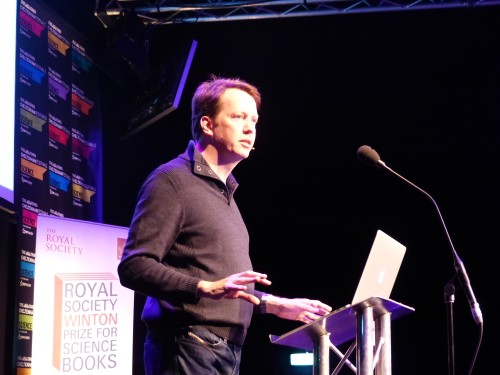
Sean Carroll in full flow at the 2014 Cheltenham Science Festival.
By Matin Durrani in Cheltenham
I made the short journey yesterday from Bristol to the regency spa town of Cheltenham, which this week is hosting its annual science festival. One of the largest such events in the UK, it’s been running since 2002 and has a packed programme of A-list speakers and topics ranging from genetics to geology, from cocktails to cake, and from the human brain to the Higgs boson.
My main reason for attending the festival, though, was to meet Caltech physicist Sean Carroll, whose book about the search for the Higgs boson (called The Particle at the End of the Universe ) was picked by Physics World last year as one of our top 10 books of 2013. Carroll was in the Gloucestershire town to give a one-hour talk about the Higgs, although the festival organizers were clearly working him hard as he also spoke in separate lectures on dark matter and dark energy, and on his role as a science adviser to Hollywood. (Carroll’s worked on films including Thor, Avengers Assemble and TRON: Legacy and even played a tiny role on TV’s The Big Bang Theory – stay tuned for more on that in our upcoming audio interview with him.)
Carroll’s lecture on the Higgs was great, but I don’t want to bore you with a detailed account of the contents as you can kind of guess (it started with Democritus, went via Newton and ended up on 4 June 2012 when the Higgs boson was discovered at CERN).
But while listening, I started wondering why exactly I was enjoying this lecture so much. So if Carroll will forgive me, here are some top tips for good lecturing based on yesterday’s lecture.
1. Start your talk right back at the beginning and don’t dive in too fast. Non-experts will appreciate you giving plenty of background, while experts are unlikely to complain if you go over old material again. As Enrico Fermi once said, “Never underestimate the joy people derive from hearing something they already know.”
2. Keep your slides simple and clean – use one font (preferably not comic sans), just one or two colours, have some nice photos (properly credited of course) and keep your text short and sweet.
3. Be enthusiastic about your topic – show you love your subject – and make it clear you know what you’re talking about.
4. Throw in some good jokes and surprise the audience with some tangential comments. (Carroll, for example, quoted lyrics from a song about magnets by the Insane Clown Posse, an American hip hop duo from Detroit, Michigan.)
5. Focus on people, where possible. Physics is done by physicists after all and there are always good stories to tell. (Carroll, for example, showed a photo of groups of young researchers camped outside CERN’s main auditorium before the discovery of the Higgs was announced, using them as a hook to ask why the subject was such a big deal to some people.)
6. Chuck in some good stats here and there, such as the temperature of the Large Hadron Collider (LHC) being lower than that of outer space (1.9 K versus 2.7 K) or the fact that 1.5 million gigabytes of data are stored by the LHC each year.
7. Keep your language clear and simple, explaining any jargon that you do need to use.
There’s probably an eighth rule too, which is to practise your lecture a lot beforehand. After all, festival organizers are only going to invite people they know are good public speakers. I guess once you can perform, you get called back again and again.
If you want to see Carroll yourselves, he’s speaking at the Royal Institution in London tonight, examining the “black-hole paradox”.
And if you have any public-speaking tips of your own, do add them below.
Another tip for speakers: engage your audience by polling to see how many think this or that, have experience with this/that, have been here/there, prefer this/that, etc.
Trackback: Blog - physicsworld.com